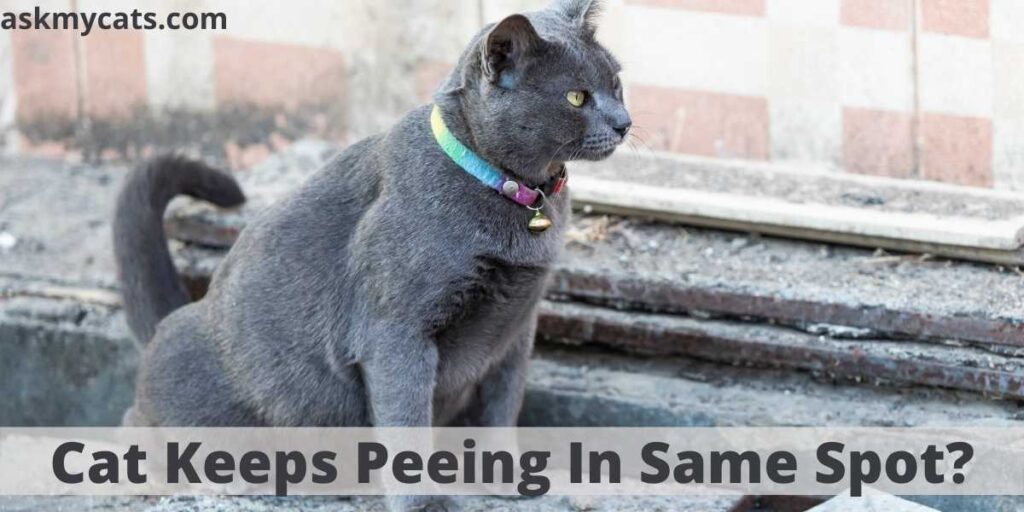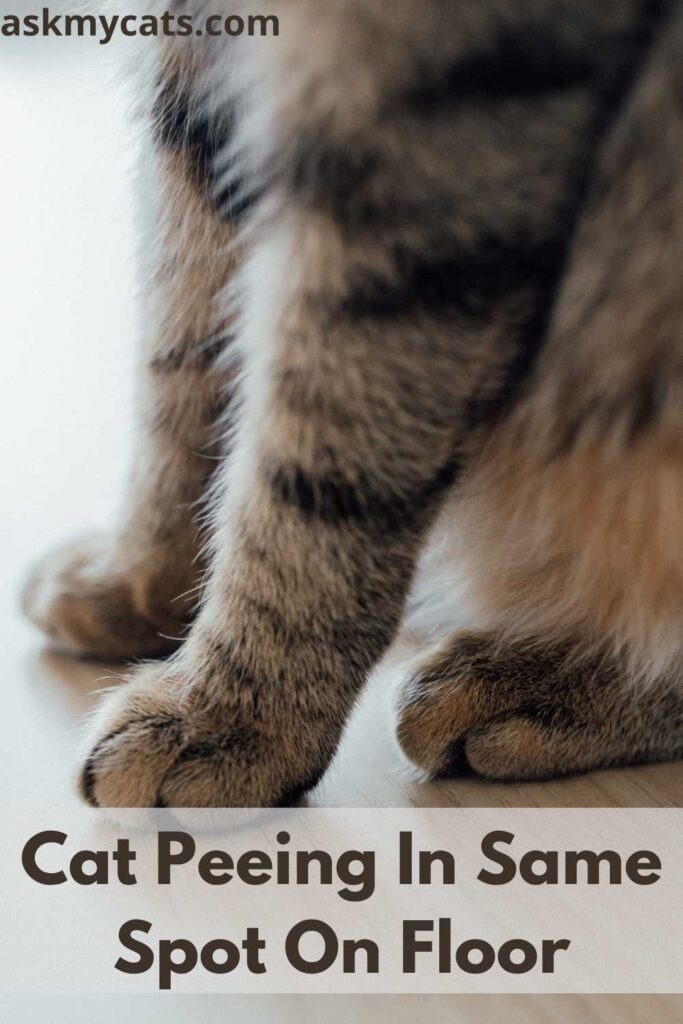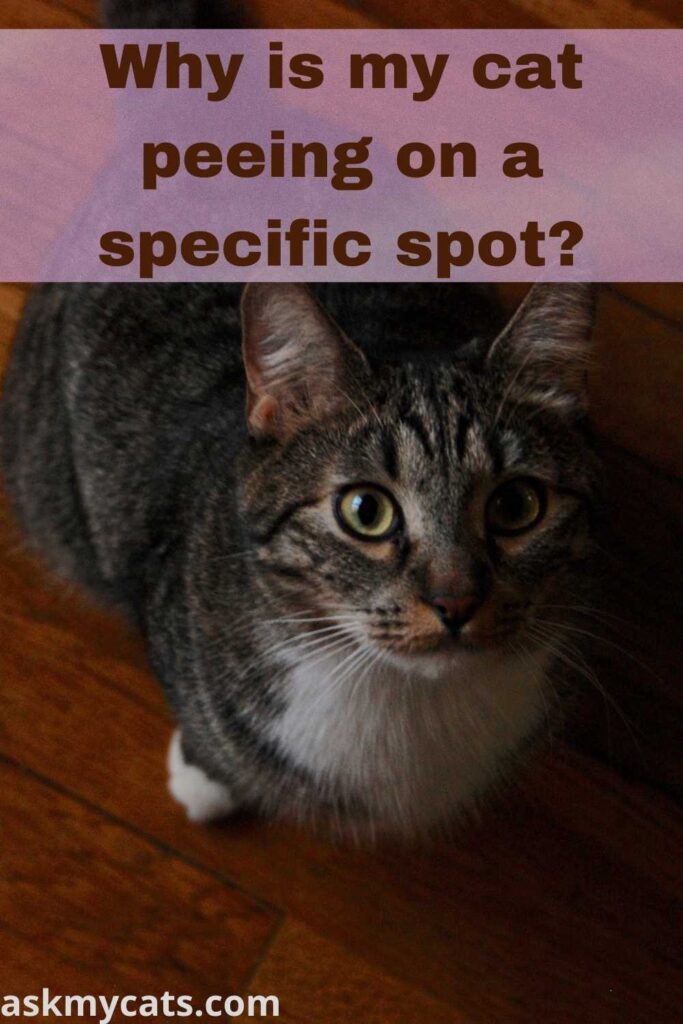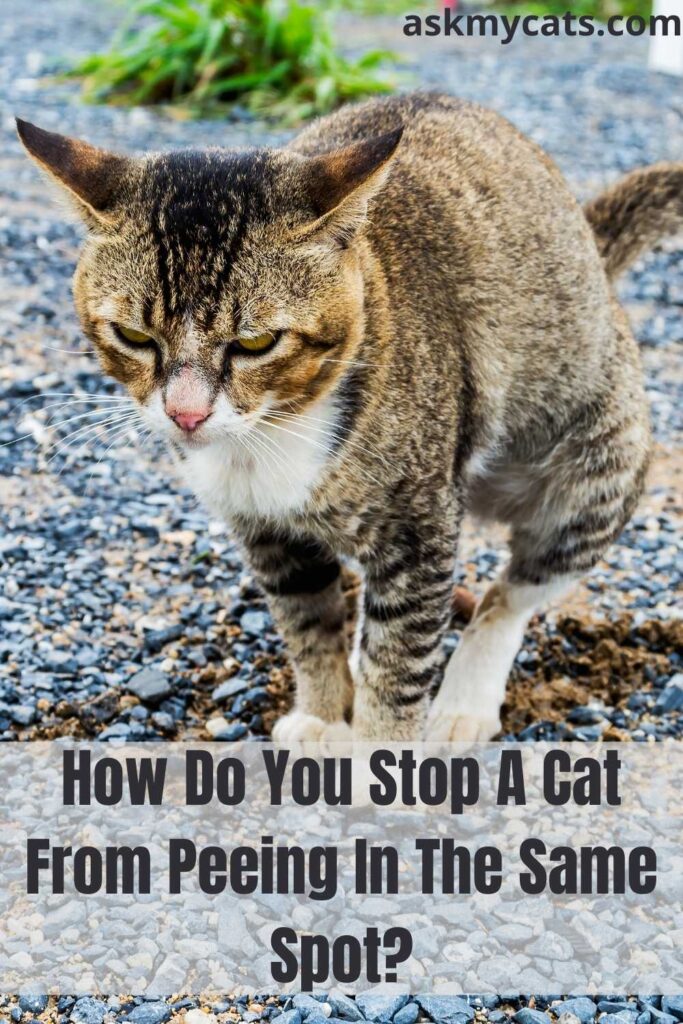Your entire house can smell like a litter box if your cat pees anywhere in the house. Cat urine includes pungent proteins that cats use to mark their territory, leaving behind an odor that is nearly impossible to remove.
Cleaning it can often reignite the odor by wetting the crystallized proteins. It can be upsetting and exhausting.
So, now the question arises why does your cat keep peeing in the same spot.
There are several reasons why your cat keeps peeing in the same spot. Health difficulties, behavioral issues, and stressful events might lead to felines urinating in inconvenient places. Once you’ve figured out what’s causing these issues, there are steps you may take to avoid urinating in an inappropriate location.
Keep reading the article to find out why your cat keeps peeing in the same spot and how can you prevent them from doing so.


Give Your Cat the Perfect Day
Get the Free Ebook!
Cat Peeing In Same Spot On Floor
Here are some reasons why your cat may be peeing in the same spot on the floor: –

1. Behavioural Causes
Cats may begin to urinate in and on the same spot on the floor for a variety of reasons.
A cat’s urination patterns can vary as a result of frustration, stress, or worry.
Any change in their habits, such as the addition of a new family member or a move, can cause urine to vary.
They may also use their urine to “mark” locations in the house as a way of establishing their territory.
Territorial “marking” is a common occurrence that can be caused by the presence or odor of another cat. Some cats, however, will “mark” their surroundings in response to stress or worry.
If a cat’s litter tray isn’t working properly, it may cause them to shift their urination patterns. They may dislike the type of litter tray, the litter material, or the location of the litter tray, or they may be turned off if the tray has been used but not cleaned.
2. Medical Causes
Inappropriate urination on the floor can be caused by disorders of the urinary system, such as bladder stones, bacterial infections, and other inflammatory conditions that cause pain and an increased need to urinate.
Kidney and liver disease might cause cats to drink more and urinate more frequently. Urinating more frequently or urgently means cats may not be able to reach their litter tray in time, or the litter tray may become dirty extremely quickly, deterring the cat from using it again until the litter is changed.
Changes in urine behaviors can be caused by age-related deterioration in brain function and hormonal illnesses such as diabetes.
The mobility and sensory function of a cat can have an impact on its urination behaviors. Medical problems that affect the nerves, muscles, or joints can cause discomfort, stiffness, or weakness, making it difficult for a cat to reach or enter the litter tray.
It’s critical to schedule an appointment with your veterinarian for a comprehensive physical examination and assessment if your cat is urinating inappropriately on the floor.
Prior to addressing any behavioral causes of urination, it’s critical to rule out any medical causes.
Please be aware that if a cat is having difficulty urinating, i.e., the cat is unable to urinate or urinates normally (signs may include straining to urinate without passing urine or without passing a normal stream of urine, with or without vocalization when urinating), they may have a urinary ‘blockage,’ which is a medical emergency.
‘Blocked’ urinating is an issue that is more common in male cats and can be lethal. If you feel your cat is blocked, please contact your veterinarian right once.
Why Is My Cat Peeing On a Specific Spot?
Here are some reasons that are causing your cat to pee on a specific spot: –

1. Marking
Cats will mark their territory to indicate “ownership” as well as sexual receptivity and availability.
The presence of other cats in the area, whether outdoors or among cats living in the same household, might cause marking.
When cats are frightened or stressed, they will also mark their territory.
Changes in household routine, compositions, living arrangements, new living places, and other environmental and societal changes can all contribute to this.
In these instances, the cat may mark new objects brought into the house or family members’ goods, particularly those with whom there is the most conflict or insecurity.
Urine is frequently observed in prominent spots or at entry and exit points to the outdoors, such as doors and windows, as well as around the periphery because marking is a technique of distinguishing territory.
When cats are outside, they tend to mark the perimeter of their property, prominent objects on the property, new objects (e.g., a new tree) introduced to the property, and areas where other cats have previously marked.
A cat can surround itself with their own familiar scents by marking. Cats “mark” territory by backing up to a vertical surface, raising their tail, treading with their back feet, the tail quivering, and directing a little stream of pee backward.
Urinating on vertical surfaces is the most common method of marking, however, it can also be done on horizontal surfaces.
Though unneutered male cats are more prone to “mark,” neutered males and females have also been observed marking.
If another cat has left their scent in the area, cleaning any areas where the other cat went and cleaning any things touched by the other cat (where possible) may help to keep your cat from marking. Please be sure that any cleaners you use around cats are safe to use.
2. Stress
Cat owners frequently struggle to comprehend their pets’ behavior, and determining when your cat is upset can be difficult.
Cats despise disruptions in their regular routines, and a sudden change in their environment can have a significant impact on their behavior.
Your cat may urinate in specific spots if you’ve just relocated or just returned from a long vacation.
For cat parents, returning from a vacation or unpacking in a new home can be stressful. It’s easy to forget to give your cat love and attention while you’re busy, but it’s vital to continue playing with your cat and establish a routine to minimize stress levels.
You might also discuss with your veterinarian the possibility of using calming medications such as melatonin to assist the animal to relax.
How Do You Stop A Cat From Peeing In The Same Spot?
Use these tips to stop our cat from peeing in the same spot: –

- Providing many litter trays in various areas throughout the house. One cat requires two trays, and each subsequent cat requires a third tray, all of which must be placed in various locations.
- Litter boxes should be positioned in areas that are pleasant to your cat. This will encourage your cat to use the tray. Cats also prefer to urinate in private, so placing the litter box in a calm spot away from any traffic or commotion in the house can assist.
Cats dislike going to the bathroom near their food or water, so keep the litter boxes away from water and food bowls, as well as areas where you feed your cat (e.g., food puzzles or areas where you scatter feed/hide food for your cat’s enrichment).
- Make sure the litter box is large enough for your cat to dig, turn around, and squat comfortably – at least 1.5 times their length (e.g. an average cat measures about 50cm nose to tail, so their litter bo should be at least 75cm long).
Many commercial litter boxes are too small, but using modified plastic storage containers, you may easily construct your own.
- Types of litter boxes: Certain litter boxes can be difficult for cats to use. For example, an elderly cat with arthritis may struggle to climb into a litter box with high sides. An elderly cat would find it much easier to access an open, uncovered litter box or one with lower sides.
Some cats do not like litter boxes that are covered, while others do. If your cat is urinating in the same spot on the floor, give them a few different types of trays to test so they may find one they like.
- Experiment with different brands/types of cat litter until you find one that your cat enjoys. Some cats prefer a litter made of sand or clay, while others prefer wood pellets or crystals.
Cats are put off by the smell of scented litter, thus unscented litter is recommended. Cats need to dig, so make sure the tray is filled to a depth of at least 6 cm with litter.
- Spot clean the litter tray every day (scoop out any waste) and replace the litter once a week at the absolute least. If you leave filthy litter out for too long, your cat may stop using their tray.
For certain cats, meticulous cleanliness of the litter tray is required. Cleaning the litter boxes several times a day may be necessary.
Because cats may be hesitant to use the litter tray if it has just been deodorized or if the cleansers have an unpleasant odor, thoroughly washing it with water after cleaning is recommended. Please make sure you clean the tray with items that are suitable for cats to use.
- If a cat digs a lot in its tray, it usually means they enjoy it. Scratching the walls near the tray or the sides of the litter tray could indicate that they don’t like something about the tray or litter, so if you notice your cat doing this, consider adjusting something about the tray and/or litter to see if they appear more at ease with their toilet.
- Cats can develop preferences for urinating on certain surfaces, such as a wooden floor or a carpet. Access to the region or object in question may be restricted, which may help to stop the cycle.
- You might also try putting a litter tray in the place where the cat has been urinating improperly, as they may have grown accustomed to doing so. If your cat uses the tray in that position, leave it there for at least one week.
If necessary, the tray can then be transferred progressively (a little each day) to a new, more appropriate position. This must be done with extreme caution to ensure that your cat follows the tray and uses it as it is relocated.
- Some cat behaviorists recommend spraying scent neutralizers on the spot where your cat has urinated in an inconvenient manner. This eliminates the odor of urine, which may reduce your cat’s desire to urinate in that location.
Simultaneously, you should place litter trays in other areas to urge your cat to urinate elsewhere. If you’re going to use smell neutralizers around cats, make sure they’re safe.
If another cat’s odors have been left around the house and have induced a shift in the resident cat’s peeing habits, it is critical to remove the other cat’s odors. This could help the resident cat’s “stress” and desire to “mark” territory.
- If a new cat has been brought into the house, multiple litter trays for each cat must be provided throughout the house.
- Changing the function of an unsuitable spot like the floor into an eating, playing, sleeping, or scratching area is another way to deter a cat from urinating there. This may diminish the cat’s desire to urinate there.
- More information can be obtained from your veterinarian. They could talk about feline pheromone sprays and diffusers, for example, which can help stressed or anxious cats.
Frequently Asked Questions
How to tackle cat’s territory issues?
Spraying is a common way for cats to indicate their territory. Cats often spray by standing in front of a vertical surface and squirting a little amount of urine on it. If you notice a splash of urine on the wall, your cat is most likely spraying rather than peeing. Male cats in good health are the most notorious sprayers. Cats should be neutered as soon as they reach puberty, which occurs around the age of 5 or 6 months. Your veterinarian can advise you on when to spay or neuter your kitten. Make your neutered cat feel more secure in his territory if he’s spraying. It may be beneficial to create different living quarters for each cat in a multi-cat home. If this isn’t possible, get some tall cat trees or perches and set up hiding spots and covered escape routes so cats may easily avoid each other. Outside your house, feral or neighborhood cats can sometimes present a territorial problem. If your cat is only allowed indoors, just seeing them through the windows can be enough to cause problems. Spraying cats may benefit from over-the-counter anxiety relievers such as Vetoquinol Zylkene calming supplement or Feliway Classic. If all else fails, your veterinarian may prescribe fluoxetine, an anti-anxiety medicine.
How to find the right litter box for the cat?
Enclosed litter boxes may match your decor and help restrict the trash and stench, but your cat may not agree. Enclosed boxes can be narrow, dark, stinky, and difficult to turn around in, making them unsuitable for cats to use. Make sure the sides of your litter boxes are low enough for your cat to step over easily, especially as they get older. Large and open with low sides or at least one low location where cats can easily enter, the ideal litter box is large and open.
How to stop a cat from peeing on the carpet?
If the problem is with the cat’s health, most of the time simply providing him or her medical attention will stop the cat from peeing on the carpet or elsewhere in the house. If the behavior is the cause of the habit, addressing the problem will help. For example, if the cat is peeing in the house as a result of a new pet or a new residence, the problem should go away over time as the cat adjusts to the changes.
Final Words
If you follow these guidelines, you should be able to stop questioning, “Why is my cat peeing on everything?”
Instead, you can enjoy the pleasures of owning a cat without having to clean up after him or her all of the time!
If you have any questions, ask us in the comments section.
